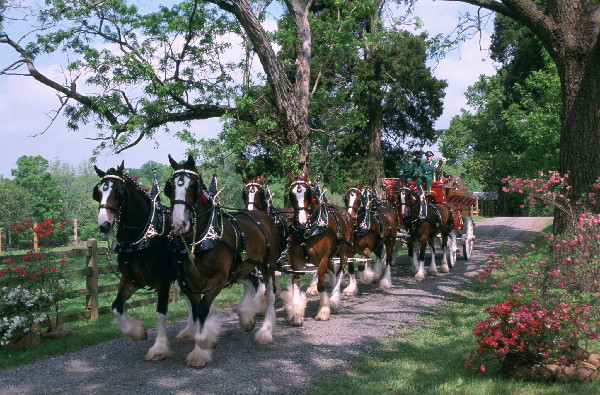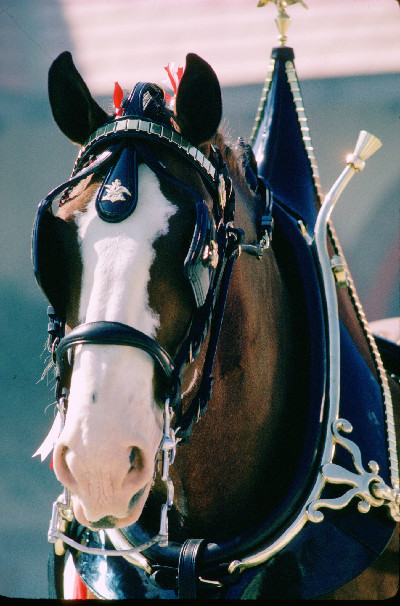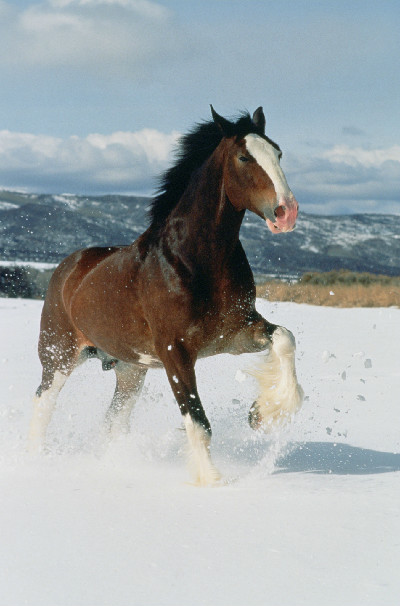Dream Jobs: Handling the Budweiser Clydesdales
by Karen Braschayko
Have you ever seen the magnificent Budweiser Clydesdales on a commercial or in a parade and wondered what it would be like to take care of them? Jeff Knapper worked his way up from handler to general manager of Clydesdale Operations for Anheuser-Busch. Here he shares behind-the-scenes info about how the show comes together and what it’s like to travel as a Clydesdale handler.
Karen Braschayko for Equitrekking: How did the Budweiser Clydesdales come to be, and what do they mean to people who meet them?
Jeff Knapper: The Clydesdales have been around since 1933. August Busch Jr. gave August Busch Sr. a team of six Clydesdales to commemorate the repeal of Prohibition. A couple of months before, they had been in Chicago at a livestock exposition. August Jr. realized how much his father enjoyed watching the big hitches, especially the Clydesdales. When they knew Prohibition might be repealed, August Jr. started the groundwork and gave August Sr. these Clydesdales.

They delivered the first case of Budweiser to the White House and to officials who were part of seeing Prohibition rescinded. It was a commemorative gift, and since then they’ve been delivering beer as a symbol of Budweiser heritage. The symbol has become synonymous with Budweiser — the quality that goes into the product itself, as well as the time, energy and passion we put into taking care of the horses.
The Clydesdales started out delivering Budweiser to people across the U.S., and that’s what we do today. In 2011, we put a tap system in the back of the wagons, so all year we sampled Budweiser to consumers across the U.S., continuing the tradition. It was a good year, and we’re excited about 2012.
Today we don’t get the opportunity to see animals that often. People are just so excited when they see the horses, their size, how they’re cared for and their gentle dispositions. People love it. It’s not every day that even equine enthusiasts see horses the size of the Clydesdales. They get excited to see the horses happy, and it’s a lot of fun. It makes the job really enjoyable.
Equitrekking: What is your background with horses, and how did it lead to working with the Budweiser Clydesdales?
Jeff Knapper: I grew up on a farm in Iowa. Cattle, agriculture and farming were all around me. I went to college for two years and got an animal science degree. I worked on cattle ranches around the U.S. and did the show circuit.
When I was a kid, I used to help friends of my parents who had Belgians. They showed at all of the Midwest fairs. When the state fair season was over and I was done showing cattle, I would help these folks at the few last fairs. So I had some basic draft horse experience, anyway.
I started in 1993 with Anheuser-Busch. The gentleman I had worked for was the lead driver of the St. Louis hitch, and he called me one day. They had some positions posted, and he asked if I’d be interested. I thought it sounded like a great opportunity, and I was at the right stage in my life. I interviewed and ended up getting hired as a handler.
I worked in many different locations as a Clydesdale handler. I went to San Antonio, San Diego, and then traveled with the St. Louis hitch for several years. I was promoted to supervisor of the St. Louis stable. Later I became a scheduling manager, working with our wholesalers and field folks on all of the details and logistics of the schedule. Then I got a new job on the event marketing side of the business. After a few years, I moved over into a sales position. Not long ago, the general manager position for Clydesdale Operations became open. I had the experience that they were looking for, so I got this job.

It is nice to be back working with the horses again. I’m an agriculture person, and you really don’t ever lose that when you grow up in that lifestyle. I am the general manager of Clydesdale Operations for Anheuser-Busch. We have just under 50 employees within Clydesdales Operations and five different locations for Clydesdale horses. I’m in charge of everything, whether it be on the herd side, the marketing side or anything Clydesdale.
It’s been really enjoyable because I started in the most entry level position we have. I worked my way through, so it’s nice to know what the crews are experiencing and relate to them. I can tweak our needs from a marketing side, and I still understand what everybody has to go through and what it actually takes to get the job done.
Equitrekking: What is the training process like for young Clydesdales?
Jeff Knapper: We’re fortunate first to have a good baseline. Clydesdales are pretty docile by nature, which is helpful for as big as they are. We have over 40 of the world’s best Clydesdale mares in our breeding herd at Warm Springs Ranch in Boonville, Missouri. We are looking for specific qualities, so we have state-of-the-art equipment and some of the best bloodlines in the Clydesdale breed. We are very focused on producing the best quality and colored geldings that we can have for the hitches.
The expecting mares are brought into the foaling barn three weeks prior to their due date, stalled at night and turned out during the day. We have cameras in all of the foaling stalls that live feed into our breeding manager’s home, and we’ve got what we call a foal alert, which is an electronic device installed on the mares. When their water breaks, it sends a signal that calls all of the employees of the breeding facility on their cell phones. John Soto, the supervisor and breeding manager at Warm Springs Ranch, lives right up the hill from our barn, so he can be there right away.

From the day a Clydesdale is born on our breeding farm, he is handled. We start trimming their feet, working with them and teaching them to lead. Once they’re weaned, they’ve been handled quite a bit. If they’re male and they have the right colors, they are selected to be on one of the traveling hitches, potentially.
Then they’ll go to Grant’s Farm in St. Louis, Missouri. That’s where we start behavioral training, just getting them used to being around people. They learn the do’s and don’ts of being a Budweiser Clydesdale or, quite frankly, a show horse. We train them with behaviors such as it’s not polite to bite, we don’t like when you kick at us, and all of the things that we have to teach the little guys. That all starts at a very young age. Once they hit three, they have the manners they need.
From there they go to the training facility in Merrimack, New Hampshire, where they are green broke to drive. That training just becomes more detailed until they are acclimated well to pulling the wagon and working with others.
Then we’ll take them into different scenarios. We are located at our brewery in Merrimack, so there are semis, trains hauling raw materials in and out, and people all around. We hitch them with more senior horses that are acclimated. We’ll take them into environments where there’s more activity and get them used to understanding that this is all good. They know that we’re looking out for their best interests, and we develop a bond so they can trust us and we trust them. It’s very similar to a lot of equine training.
Equitrekking: What is life like for the horses when they go on tour?
Jeff Knapper: For the traveling horses, each team has seven handlers. They all drive the trucks, clean the stalls, feed the horses and groom them. A normal day starts at 7 a.m. The horses are all fed, they’re taken out in groups, the stalls are cleaned, and then they come back in and get groomed.
They get a full body wash once a week. Every show day, they get their four white legs, or feathers, washed with soap and water. They are clipped weekly, and their manes and tails are kept trimmed. They are blanketed at all times, even with a light sheet in the summer. They get the best care, and it’s the job of the handlers to stay focused on the horses. There are people around them almost all day.

Equitrekking: What are the biggest perks of the job?
Jeff Knapper: Well, that’s tough because there are so many. You get access to so many interesting people, and you can learn so much. People know that we’re here for the horses, that we do everything we can to make sure the horses get the best care, and that’s portrayed in the people we’re around. We’re in fun environments, and we get to see neat places and meet a lot of fun people. That’s huge and great piece of the job.
We’re very fortunate because we have the time, resources and people to go at this in a process that works for the long term and for everybody. You know the horses get a positive feeling, there’s that bond we build, and that’s what it’s all about. It’s especially important once you get out on the road and into major parades, festivals and things that are out of the norm. The horses trust that they’re in good hands, and there’s just a good relationship there.
Resources can be a lot of things. It’s not so much monetary but that we have what we need. What I think is so important is that I have access to everybody. I can call some of the greatest in whatever area we need, whether it’s farriers, nutritionists, veterinarians or trainers. That is very exciting, because you can learn so much from so many people.
We also have our hitch driving school. It’s new for 2012, and we’re going to have our first candidates starting in March. It’s an internal training program to teach future hitch drivers how to drive eight horses. It’s a unique ability, and not everybody has it. A lot of people who come to us may have driven teams of four but not have the experience driving eight horses. We’ve got a group of folks who are extremely talented at driving hitches, and they’ll be teaching potential employees. So we’re excited about that as well.
Equitrekking: Do you have any interesting stories about working with the Clydesdales?
Jeff Knapper: I’ve got a million. I’ve been to the World Series, Super Bowls, victory parades and NASCAR races. You meet a lot of really neat people, including celebrities. I’ve been to Mexico and Canada with the horses. I did a three-week trip with the St. Louis hitch to Mexico, and that was an experience of a lifetime. We went down into the interior and spent three weeks. That was incredible.
We just shot this year’s Super Bowl commercial out in Thousand Oaks, California. The farm we stay at, back in its day, was one of the biggest hunter-jumper operations. It’s just an amazing facility. We get to stay at people’s private stables fairly often. There are so many neat farms and barns. I always say that when I retire I’m going be a horse barn designer. I’ve seen every style and kind, and that to me is a very cool part of the job.
I’ve been on many commercial shoots. They are great experiences. Working with the actors, Hollywood, and everything that goes into production is very interesting. I’ve been on multiple still photo shoots in Colorado and in the desert for our annual Budweiser Clydesdale calendar. Putting a production together with professional photographers and getting all the right shots for still photos is really fun.

It’s also interesting just going to local hometowns. We’re on the road 40 to 45 weeks a year, so that’s a different town every week. It’s not like traditional business travel where you fly in and rent a car. Here, you’re welcomed by the local people, and you’re working with your local Budweiser wholesaler. You see the good nature of the town, the inner workings, the cool historic landmarks, and people want to show you the things that make them proud. I really don’t know how you’d get that from another traveling position, the closeness and being part of the local community. I have dear friends all over the United States, relationships built while traveling with the horses.
Equitrekking: What are some challenges of the job?
Jeff Knapper: I tell everybody this because I’ve been there. The entry-level position is a traveling position, and it’s traveling on one of the three teams around the U.S. — West Coast, East Coast or St. Louis. A new hire can plan on traveling about 300 days a year. When you do come home, your schedule is driven around the horses. You get a very limited opportunity to get home and do the things that a 9-to-5 job can afford you.
Depending on the person and the progression through the organization, you could be in a traveling position for many years. Some people retire from those positions, but for some that might not be what they want to do. There’s not a huge turnover rate in management positions at our home base locations, so that may mean that they’ll have to look outside the company for other opportunities. That honestly is the biggest challenge.
Usually it takes three to five years before the traveling lifestyle becomes monotonous and a challenge, because it is such a neat job. You go to such cool places and see things that most people will never see. That’s the point where people can say, I’ve had a good time and I think I’m going to explore other opportunities.

Equitrekking: If I wanted to work with the Budweiser Clydesdales, how could I achieve that goal?
Jeff Knapper: We do want people to know that they can be considered for opportunities here. That’s realistic. We’re a large organization, and we have jobs available occasionally. We post all of our positions on BuschJobs.com. We have an open handler position on the East Coast currently.
There are three things here, and we’re looking for good people who want to put a balance between them. It’s a passion for the Clydesdales, a passion for the beer, and a passion for working with the public. Those are really the three things I look for when I talk to people about what the job entails. It’s not just horses, though that’s a huge part of it.
When I look at a resume, I’m looking for an agriculture background, not necessarily equine. Whether it be row crop, cattle or maybe rodeo, I look for something that shows that the candidate has a base knowledge of the business. We’re looking for people with a four-year degree, preferably. It doesn’t necessarily have to be an animal science background but somewhere on the business or marketing side of agriculture.
We’re looking for a diverse set of employees, all kind of balanced around what I term that agriculture industry experience. Some of our employees are extremely experienced in horse husbandry, and we have others who aren’t quite as experienced but have a really strong consumer service background. We also have people who came from our wholesaler system and have a basic knowledge of Ag or equine business, and they are passionate about the Budweiser brand and marketing beer.
We also seek an outgoing personality. I look for someone who has diverse experience on their resume, showing that they’ve been out in the world and they’re not afraid to meet new people or take new challenges.
How you can go: There are five locations to visit the Budweiser Clydesdales at home, or catch them on tour near you. Find their schedule at Budweiser.com.
Warm Springs Ranch is a state-of-the-art, 300-acre Clydesdale breeding facility and home to 100 horses. It’s located in Boonville, Missouri, about two hours northwest of St. Louis. Tours are available April 1 through the end of October and must be prearranged. Visit WarmSpringsRanch.com for more information.
Grant’s Farm is the historic home of the Busch family and a great St. Louis attraction. Young horses are prepared there for training. It’s also home to the retired horses, so it’s a great place to meet the Clydesdales. The barns are open for tours during the summer. Visit GrantsFarm.com for info.
The Anheuser-Busch Brewery just south of downtown St. Louis houses the Midwest hitch and is home to seven to 17 horses, depending on the travel schedule. The Clydesdale stable is a national historic landmark. Guided tours are free daily.
The Anheuser-Busch Brewery in Merrimack, New Hampshire, is home to the East Coast traveling team, the Clydesdale training facility and the hitch driving school. Find tour information at BudweiserTours.com.
In Fort Collins, Colorado, the Anheuser-Busch Brewery is the home base of the West Coast traveling team. The horses are available for visits when they are not on the road. Visit their website for more information.




